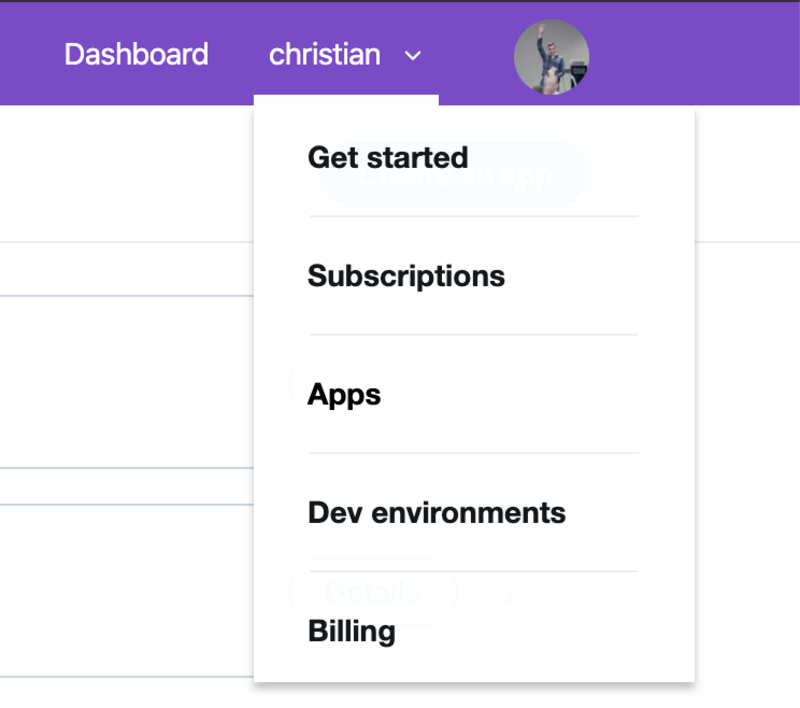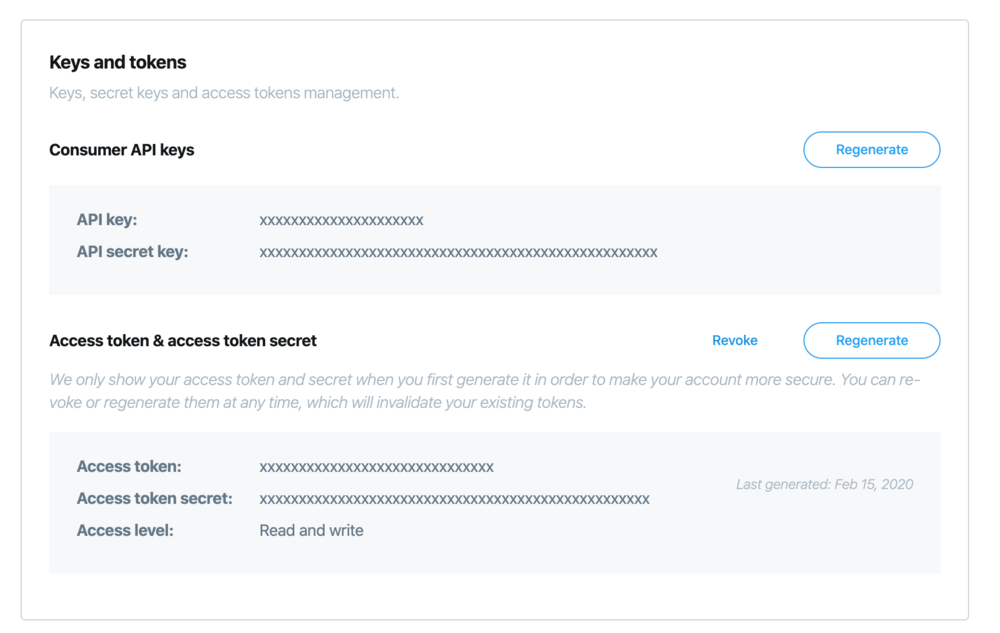Curious about how to call an HTTP API like Twitter or GitHub by authenticating through OAuth (1.0a and 2.0)?
Read more about how to do it with Node.js
Learn how to create Twitter login with OAuth 1.0a.
About OAuth
There are different ways to authenticate with OAuth on the Twitter platform.
Below you can read a bit more about OAuth 1.0a and OAuth 2.0 Bearer authentication methods and a step-by-step explanation of the usage in Node.js
OAuth 1.0a method
Many endpoints of the Twitter API use the OAuth 1.0a method to act, or make API requests, on behalf of a Twitter account.
With a Twitter developer app, you can make requests on behalf of a Twitter account as long as that user authenticated through the Twitter login screen to your app.
OAuth 2.0 Bearer Token
OAuth 2.0 Bearer Token is the application-only authentication method for authenticating with the Twitter API.
This method doesn’t involve any user authentication and is typically used for read-only access to public information on the Twitter API.
Get the necessary keys
- Go to developer.twitter.com/en/apps, login and click on Apps in the upper right menu:

- Now you need to create an app to authenticate to the Twitter API:

- generate consumer key and secret
In you applications tab you will alredy see you Consumer API Key and Consumer API Secret Key.
Click on Generate to get also the Access Token and Access Token Secret:

Here is the app overview screen:

Now you have everything you need!
Node.js example with OAuth 1.0a
When working with OAuth 1.0a you need to get a request token and access token to authenticate to the Twitter API.
This is where the npm package oauth comes in handy.
You need the following credentials set as environment variables when running the below Node.js script:
- TWITTER_CONSUMER_KEY
- TWITTER_CONSUMER_SECRET
- TWITTER_ACCESS_KEY
- TWITTER_ACCESS_TOKEN_SECRET
Install the dependency oauth with npm (npm install oauth).
The file oauth1.js should look like this and it gets the profile info of the user with the handle @twitterdev
#!/usr/bin/env node
const OAuth = require('oauth')
const { promisify } = require('util')
getTwitterUserProfileWithOAuth1('twitterdev')
.then((profile) => console.log('oauth1 response', JSON.stringify(profile, null, 2)) && process.exit(0))
.catch(err => console.error(err) && process.exit(1))
async function getTwitterUserProfileWithOAuth1 (username = 'twitterdev') {
var oauth = new OAuth.OAuth(
'https://api.twitter.com/oauth/request_token',
'https://api.twitter.com/oauth/access_token',
process.env.TWITTER_CONSUMER_KEY,
process.env.TWITTER_CONSUMER_SECRET,
'1.0A', null, 'HMAC-SHA1'
)
const get = promisify(oauth.get.bind(oauth))
const body = await get(
`https://api.twitter.com/1.1/users/show.json?screen_name=${username}`,
process.env.TWITTER_ACCESS_KEY,
process.env.TWITTER_ACCESS_TOKEN_SECRET
)
return JSON.parse(body)
}Run oauth1.js with node:
TWITTER_ACCESS_KEY=[YOUR_TWITTER_ACCESS_KEY] \
TWITTER_ACCESS_TOKEN_SECRET=[YOUR_TWITTER_ACCESS_TOKEN_SECRET] \
TWITTER_CONSUMER_KEY=[YOUR_TWITTER_CONSUMER_KEY] \
TWITTER_CONSUMER_SECRET=[YOUR_TWITTER_CONSUMER_SECRET] \
node oauth1.jsPS: the #!/usr/bin/env node part is useful if you want to make your Node.js script an executable (chmod +x oauth1.js)
Node.js example with OAuth 2.0
With OAuth 2.0 the authentication is even simpler, but more limited on its actions, as you can read above.
You’ll need both the TWITTER_CONSUMER_KEY and TWITTER_CONSUMER_SECRET to get a Bearer token to call the Twitter API.
Here is an example, the file oauth2.js should look like this (it also gets the profile information of the user @twitterdev)
#!/usr/bin/env node
const OAuth = require('oauth')
const got = require('got')
const { promisify } = require('util')
getTwitterUserProfileWithOAuth2('twitterdev')
.then((profile) => console.log('oauth2 response', JSON.stringify(profile, null, 2)) && process.exit(0))
.catch(err => console.error(err) && process.exit(1))
async function getTwitterUserProfileWithOAuth2 (username = 'twitterdev') {
var oauth2 = new OAuth.OAuth2(
process.env.TWITTER_CONSUMER_KEY,
process.env.TWITTER_CONSUMER_SECRET,
'https://api.twitter.com/', null, 'oauth2/token', null
)
const getOAuthAccessToken = promisify(oauth2.getOAuthAccessToken.bind(oauth2))
const accessToken = await getOAuthAccessToken('', { grant_type: 'client_credentials' })
return got(`https://api.twitter.com/1.1/users/show.json?screen_name=${username}`, {
headers: {
Authorization: `Bearer ${accessToken}`
}
})
.then((res) => JSON.parse(res.body))
}
Run oauth2.js with node:
TWITTER_CONSUMER_KEY=[YOUR_TWITTER_CONSUMER_KEY] \
TWITTER_CONSUMER_SECRET=[YOUR_TWITTER_CONSUMER_SECRET] \
node oauth2.jsIn this case the API /1.1/users/show.json supports both OAuth 1.0a and OAuth 2.0.
Some APIs (depending on their scope) will need one or the other, it should be well documented.
Wrapping it up
On the github repository you can find the full source code!
Clone it with
# https
git clone https://github.com/christian-fei/twitter-oauth-by-example-in-nodejs.git
# or ssh
git clone [email protected]:christian-fei/twitter-oauth-by-example-in-nodejs.gitEnjoy
sidenote: OAuth2 with curl
Getting an access token that can be used to authenticate via Bearer authentication can be easily achieved with curl:
curl \
-u '<YOUR_TWITTER_CONSUMER_KEY>:<YOUR_TWITTER_CONSUMER_SECRET>' \
--data 'grant_type=client_credentials' \
'https://api.twitter.com/oauth2/token'and the response will look something like this:
{"token_type":"bearer","access_token":"AAAAAAAAA..."}Now we can authenticate with the access_token to the twitter api, using Bearer authorization scheme:
curl --header 'Authorization: Bearer AAAAAAAAA...' 'https://api.twitter.com/1.1/users/show.json?screen_name=devcri'returning more information about the twitter user profile devcri:
{
"id":128166532,
"id_str":"128166532",
"name":"\/christian\/\ud83c\udf55",
"screen_name":"devcri",
"location":"The Internet"
,"profile_location":null,
"description":"agile person, clean code connoisseur and testing aficionado",
"url":"https:\/\/t.co\/qUleUCEuNH",
"entities":{"url":{"urls":[{"url":"https:\/\/t.co\/qUleUCEuNH",
"expanded_url":"https:\/\/christianfei.com\/",
"display_url":"christianfei.com",
"indices":[0,23]}]},
"description":{"urls":[]}},
"protected":false,
"followers_count":567
,"friends_count":133,
"listed_count":111,
"created_at":"Wed Mar 31 08:55:25 +0000 2010",
"statuses_count":12795,
...Learn how to create Twitter login with OAuth 1.0a.
 Chris
Chris